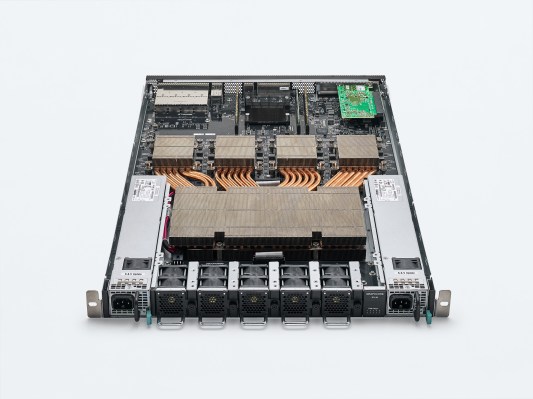There is a lot riding on the use of artificial intelligence technology to help us take giant leaps ahead in solving complex challenges — whether it’s medical breakthroughs, building better cybersecurity or creating better navigation systems for cars and other moving objects. But the more advanced the application, the bigger the need for hardware that can handle the calculations and processing; and that means the race is on for ever-more powerful processing. Now, the U.K. startup Graphcore is announcing its latest contribution to that effort.
Today, it is announcing a new chip, the GC200, and a new IPU Machine that runs on it, the M2000, which Graphcore says is the first AI computer to achieve a petaflop of processing power “in the size of a pizza box.”
Graphcore says there are no plans for the GC200 to be sold separately, and it will come only in the M2000. CEO and co-founder Nigel Toon said the M2000 is now shipping to early access customers and will be more widely available by the end of this year to customers in applications in areas like financial services, healthcare, technology and more, “wherever AI is used.”
This is the second generation of Graphcore’s hardware to be released, and its first in just less than two years, Toon notes.
The IPU Machine uses four of the 7nm GC200 IPU chips, with the GC200 featuring 59.4 billion transistors on each chip. Potentially, Graphcore says that up to 64,000 IPUs can be connected together to create a vast parallel processor of up to 16 exaflops of computing power and petabytes of memory to support models with trillions of parameters. The idea is that these can be scaled up as necessary.
The moves come at a key moment both for Graphcore and the AI hardware industry. The U.K. upstart competes against leviathans in the world of processors, like Nvidia and Intel — Graphcore raised a further $150 million in May at a nearly $2 billion valuation to compete against them, and Toon says the $450 million it has raised so far is enough for now, with customers like Microsoft and others already on its books — but also a plethora of other companies building AI chips. And it was only in May that Nvidia unveiled its own latest chip, the A100, its first Ampere-based GPU that promises 5 petaflops of performance.
Graphcore and its leader Toon — who, with his co-founder Simon Knowles had sold a previous startup called Icera to Nvidia — argue that its IPU approach is more efficient and advanced than the GPU route that Nvidia is taking.
“We are trying to build products that are easy to put into your existing compute infrastructure,” he said. “It means you can scale up to thousands of IPU processors.” And, he added, that means that the cost of ownership can be 10-20 times lower for the IPU approach, which in turn translates to faster take-up of the hardware.
Toon says that while other chipmakers continue to work on a number of other processing applications in parallel with AI — for example for mobile devices, or quantum chips — Graphcore is remaining firmly focused on AI applications, which he says remains a “massive opportunity for us to grow our business and add more customers.”
“We’re 100% focused on silicon processors for AI, and on building systems that can plug into existing centers. Why would we want to build CPUs or GPUs if those already work well? This is just a different toolbox.” He said he believes it will be a 10 to 15-year window before quantum or molecular computing comes along, a trajectory that might pose a lot of challenges for smaller startups trying to build in that area against biggies like IBM.
Toon noted that AI stands among the trends that the COVID-19 pandemic has accelerated — not just around the many applications being pursued around the health crisis and fighting the virus itself, but also around working and improving processes for other services resulting from that.
“We’ll probably burn $100 million more investing in technology and people” — the company now has 450 employees, Toon noted, “but our revenues are also ramping, and the $300 million in cash we have today should be sufficient to get us to a fast and profitable business.”
